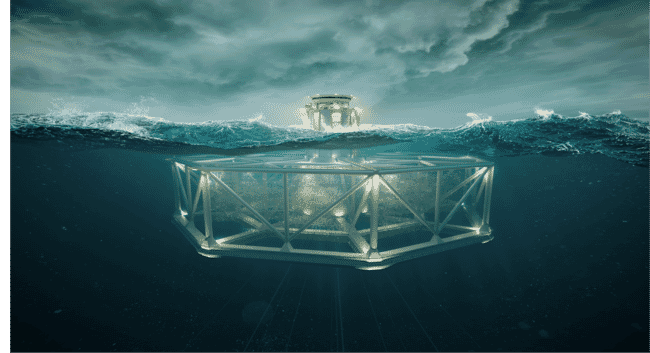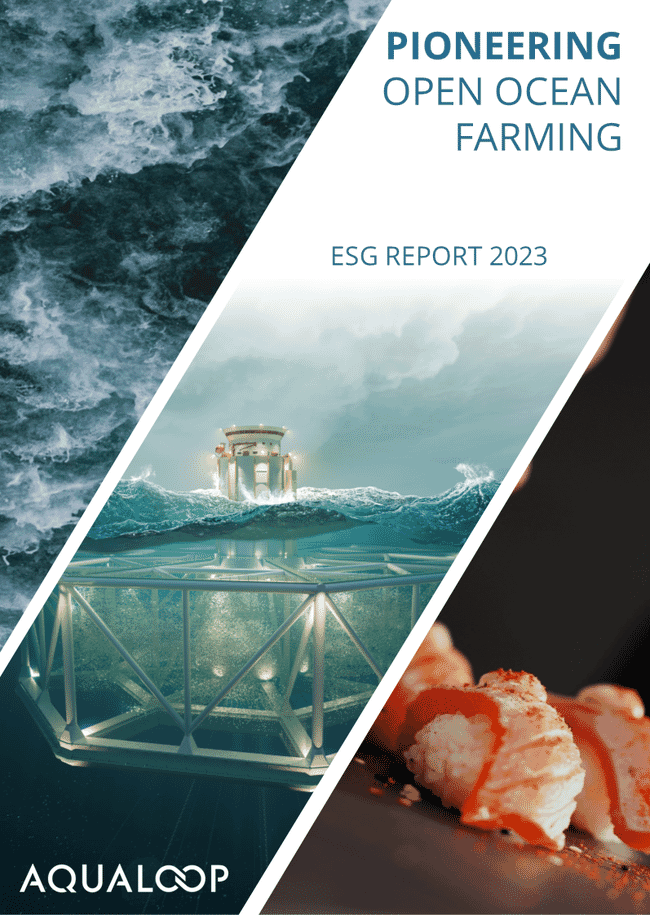
Offshore aquaculture has huge potential, but its long-term success will rely on the development of rugged, yet affordable farming systems
This report, which was compiled by Hatch Innovation Services, highlights AquaLoop’s ESG goals. These include achieving zero emissions in various production processes, addressing climate change, preserving water quality and ecosystems, using sustainable fish feed, enhancing fish welfare, ensuring regulatory compliance, and emphasising workforce development and equality. The company has partnered with TerraVera, a renowned non-profit organisation which is dedicated to demystifying true sustainability in companies, ensuring clarity and transparency.
As Bård Skjelstad, CEO of AquaLoop, explains: “With few possibilities to increase salmon production in traditional coastal farms, it seems as if the interest and expectations towards utilizing offshore environment has a common, global ground – much so because in addition to space and fish welfare it comes with a great economic viability. .”
Tanja Hoel, director of Hatch Innovation Services, adds: “Offshore technology has the potential to open up new farming locations with optimal environmental conditions. Considering our planet is 70 percent ocean, it makes sense to explore new areas for ocean food production. The Aqualoop Big Dipper is an impressive concept, integrating over 40 years of Norwegian offshore technology into its core design. In open oceans, fish benefit from high water exchange rates, good oxygen supplies and less exposure to environmental challenges.”
While the system is being developed in Norway, the company sees Europe and North America as the primary markets, followed by the Asia-Pacific (APAC) region - with a focus on deep-water marine environments with high rates of water circulation.

The report was compiled by Hatch Innovation Services
ESG insights
The report details how the AquaLoop Big Dipper aims to change the way food is produced and how this process impacts the planet. The company aims to sell and licence the technology, initially focusing on salmon production.
Below are some of the key ESG targets, with a focus encompassing people, ocean, climate and fish welfare:
Climate
Utilising the Norwegian oil and gas industry standards, the AquaLoop Big Dipper enables salmon production in high water-exchange environments, addressing coastal farming challenges like sea lice and disease. This enhances operational efficiency, product quality, and sustainability compared to traditional coastal net-pen aquaculture.
AquaLoop’s commitment to circularity is reflected by the effort in pursuing net zero target by 2040, AquaLoop is in collaboration with Moss Maritime for zero emissions and energy efficiency. The focus extends to recycling all its plastics and designing equipment with a 25-year lifecycle.
Ocean
To safeguard biodiversity and marine health, Aqualoop sets targets for zero escapes and zero fatal impacts on marine life. Therefore, the AquaLoop Big Dipper is designed free of lines, cables, or other entanglement hazards, showing a consideration for marine life. Despite implementing proactive safeguards, the company is keenly aware of its environmental impact, particularly concerning noise and light pollution. Recognising the likely effects of light pollution on the surrounding ecosystem, AquaLoop remains committed to continual monitoring and evaluation of the wildlife around its sites.
AquaLoop's stringent criteria for feed and 100 percent deforestation-free soy sourcing contribute to environmental sustainability. They aim for an eFIFO of 1.08, potentially becoming the lowest emission source of animal protein, and seek partnerships with sustainable feed suppliers to combat deforestation and promote low-carbon feed.
People
AquaLoop's governance structure is designed to ensure accountability, transparency, and integrity in all aspects of its operations. This includes a strong focus on ethical sourcing, responsible supply chain management, and the establishment of clear policies and procedures to guide the company's environmental and social practices. AquaLoop’s strategy aims to benefit local communities by sourcing from them, establishing internship and research programs, and conducting employee surveys. The company prioritises workforce well-being, aiming for zero injuries and zero tolerance to discrimination, setting a high standard for workplace safety and inclusivity.
Fish welfare
The company is developing extensive fish welfare protocols, and implementing specialised fish handling systems to minimise stress and disease risks. The Big Dipper's design - featuring multiple cage chambers and a submerged profile - enables healthier salmon, marked by increased feed efficiency, increased survival rates, lower energy consumption, and minimised emissions.
A key innovation of the Aqualoop Big Dipper is its capability to nurture smaller smolts in secure, protected environments near the single-point mooring pen until they reach 500-800 g before moving them to larger open cages.
The system also contains a specialised fish handling system, designed to minimise stress and trauma during transport, mitigate disease risks, and reduce transport costs. The company aims for over 95 percent of its salmon to achieve superior quality, with no sea lice and zero use of antibiotics.
Food security
Reflecting on the new report, Skjelstad states: “With the human population growth projected to reach 9.8 billion in 2050, space on land and coasts for equitable food production is becoming limited. Open ocean mariculture can help address this challenge. We are pleased to see that the vision of open ocean farming is now shared by most and that regulations and other premises are falling into place.
“Our inaugural ESG report aims to set a new benchmark for open ocean farming, showcasing their commitment to operational excellence, environmental protection, fish welfare and social responsibility.“




